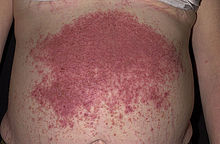| Dermatitis herpetiformis | |
|---|---|
| Other names | Duhring's disease[1][2] |
 | |
| Characteristic rash of dermatitis herpetiformis | |
| Specialty | Dermatology |
Dermatitis herpetiformis (DH) is a chronic autoimmune blistering skin condition,[3] characterised by intensely itchy blisters filled with a watery fluid.[4] DH is a cutaneous manifestation of coeliac disease,[5] although the exact causal mechanism is not known. DH is neither related to nor caused by herpes virus; the name means that it is a skin inflammation having an appearance (Latin: -formis) similar to herpes.
The age of onset is usually about 15 to 40, but DH also may affect children and the elderly. Men are slightly more affected than women.[6] Estimates of DH prevalence vary from 1 in 400 to 1 in 10,000. It is most common in patients of northern European and northern Indian ancestry, and is associated with the human leukocyte antigen (HLA) haplotype HLA-DQ2 or HLA-DQ8 along with coeliac disease and gluten sensitivity.[7][8][9][10][11]
Dermatitis herpetiformis was first described by Louis Adolphus Duhring in 1884.[12] A connection between DH and coeliac disease was recognized in 1967.[12][13]
- ^ Freedberg, et al. (2003). Fitzpatrick's Dermatology in General Medicine. (6th ed.). McGraw-Hill. ISBN 0-07-138076-0.
- ^ Rapini, Ronald P.; Bolognia, Jean L.; Jorizzo, Joseph L. (2007). Dermatology: 2-Volume Set. St. Louis: Mosby. ISBN 978-1-4160-2999-1.
- ^ Singal A, Bhattacharya SN, Baruah MC (2002). "Dermatitis herpetiformis and rheumatoid arthritis". Indian J Dermatol Venereol Leprol. 68 (4): 229–30. PMID 17656946.
- ^ Cite error: The named reference
AOCDwas invoked but never defined (see the help page). - ^ "Dermatitis Herpetiformis". Retrieved 2015-04-20.[permanent dead link]
- ^ Salmi, T. T.; Hervonen, K.; Kautiainen, H.; Collin, P.; Reunala, T. (August 2011). "Prevalence and incidence of dermatitis herpetiformis: a 40-year prospective study from Finland". The British Journal of Dermatology. 165 (2): 354–359. doi:10.1111/j.1365-2133.2011.10385.x. ISSN 1365-2133. PMID 21517799. S2CID 23165241.
- ^ Miller JL, Collins K, Sams HH, Boyd A (2007-05-18). "Dermatitis Herpetiformis". emedicine from WebMD.
{{cite journal}}: Cite journal requires|journal=(help) - ^ Cite error: The named reference
pmid18319038was invoked but never defined (see the help page). - ^ "Dermatitis Herpetiformis". Patient UK. Archived from the original on 2013-07-06. Retrieved 2009-07-22.
- ^ "Dermatitis Herpetiformis". National Digestive Diseases Information Clearinghouse. Archived from the original on 2009-07-20. Retrieved 2009-07-22.
- ^ Spurkland, A.; Ingvarsson, G.; Falk, E. S.; Knutsen, I.; Sollid, L. M.; Thorsby, E. (January 1997). "Dermatitis herpetiformis and celiac disease are both primarily associated with the HLA-DQ (alpha 1*0501, beta 1*02) or the HLA-DQ (alpha 1*03, beta 1*0302) heterodimers". Tissue Antigens. 49 (1): 29–34. doi:10.1111/j.1399-0039.1997.tb02706.x. ISSN 0001-2815. PMID 9027962.
- ^ a b "What Is Dermatitis Herpetiformis?".
- ^ Marietta EV, Camilleri MJ, Castro LA, Krause PK, Pittelkow MR, Murray JA (February 2008). "Transglutaminase autoantibodies in dermatitis herpetiformis and celiac sprue". J. Invest. Dermatol. 128 (2): 332–5. doi:10.1038/sj.jid.5701041. PMID 17762854.